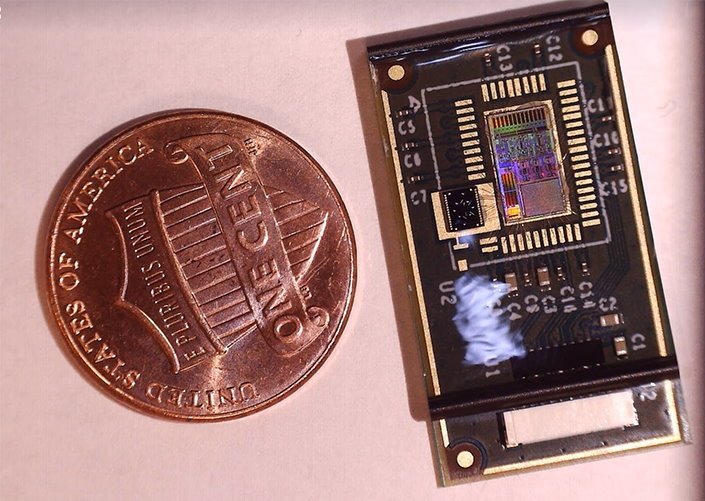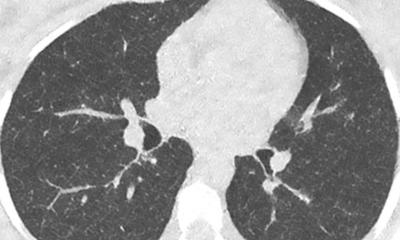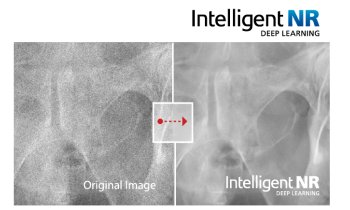
Image source: NIBIB; photo courtesy of StethX and the Georgia Institute of Technology (adapted from: Sang B et al., Biosensors 2024 (CC BY 4.0)
News • Sensor solution
Wearable lung patch uses deep learning to detect asthma and COPD
Wheezing, a high-pitched whistling sound, is a common indicator of chronic respiratory diseases, including asthma and chronic obstructive pulmonary disease (COPD), due to inflammation and swelling of the airways.
In 2023, nearly 9% percent of all adults in the United States had asthma, and COPD remains a leading cause of death in the U.S. Early detection and management of asthma and COPD is critical. Globally, asthma and COPD are under-diagnosed (20-70% for asthma and up to 81% for COPD). In addition, the U.S. Centers for Disease Control and Prevention estimate that asthma is uncontrolled in 50% of children and 62% of adults, resulting in frequent and intense episodes that can lead to increased emergency department visits and missed school days and workdays.
While digital stethoscopes are an improvement over their traditional conterparts, they pick up airborne noise, which interferes with wheeze detection. An advanced technological solution is needed that could be used as a screening tool in the clinic and for remote patient monitoring, which would enable physicians to intervene early.
Researchers at the Georgia Institute of Technology have developed a deep learning (DL) model that they paired with a wearable patch equipped with a highly sensitive sensor that can automatically detect wheezing sounds. The deep learning model has the potential to classify respiratory diseases, which could speed up their diagnosis and treatment. The results of the pilot patient study were published in BioSensors.
By incorporating data from these wheeze variations into a deep learning model, and by taking advantage of the sensor’s ability to eliminate ambient sounds, our detection method led to higher accuracy, sensitivity, and specificity compared to the standard time-frequency approach
Farrokh Ayazi
Physicians typically use digital stethoscopes (the gold standard) to listen to and record abnormal lung sounds like wheezing and crackles, which are clicking and rattling sounds that can accompany wheezing. They listen to each recording to determine whether the sounds are a wheeze, crackle, or normal breath sounds. The standard method of labeling data as a wheeze involves a computerized time-frequency analysis that uses a checklist (i.e. an algorithm) to determine whether a wheeze meets certain requirements. However, the algorithm is not comprehensive, leading to some cases being missed, according to the researchers.
The researchers designed a new wearable device to address these shortcomings. The patch has a microchip sensor, which unlike traditional microphones in digital stethoscopes, can detect tiny vibrations at a high sensitivity with minimal distortion. “Our sensitive patch has many advantages over traditional wheeze detection, which struggles to detect all variations of wheezes and crackles, which can lead to misdiagnosis,” said Farrokh Ayazi, Ph.D., senior study author and a professor in electrical and computer engineering at Georgia Institute of Technology. “By incorporating data from these wheeze variations into a deep learning model, and by taking advantage of the sensor’s ability to eliminate ambient sounds, our detection method led to higher accuracy, sensitivity [it correctly identified the presence of a wheeze], and specificity [it correctly identified absence of a wheeze] compared to the standard time-frequency approach,” he said.
Lung sound recordings were taken from 52 patients in an outpatient asthma clinic or a hospital setting. Twenty-five of the 52 patients were obese, which can interfere with the quality of traditional lung recordings. To obtain the recordings, patients wore the miniature patch on up to nine different sites on their chest. Data was recorded from each location while the patient took deep breaths for 30 seconds at a time. For comparison, physicians also obtained lung recordings using digital stethoscopes on the same chest sites.
Physicians listened to the recordings from both sources and labeled whether they heard wheezing or not in a blinded experiment and later provided a diagnosis after the clinical evaluation. The labeled wheezes were highly aligned between the digital stethoscope and the wearable patch, even for obese patients. The clinician-labeled data were incorporated into the deep learning model so it could distinguish wheezing sounds from normal breath sounds.
Recommended article

Article • Technology overview
Artificial intelligence (AI) in healthcare
With the help of artificial intelligence, computers are to simulate human thought processes. Machine learning is intended to support almost all medical specialties. But what is going on inside an AI algorithm, what are its decisions based on? Can you even entrust a medical diagnosis to a machine? Clarifying these questions remains a central aspect of AI research and development.
The researchers compared the deep learning model to the standard time-frequency method for wheeze detection when paired with the patch or the digital stethoscope. The deep learning model paired with the patch consistently had the highest average accuracy, sensitivity, and specificity rates for wheeze detection: 95%, 96%, and 93% respectively. This combination outperformed the time-frequency method paired with the patch or the digital stethoscope, and the deep learning method paired with the digital stethoscope.
The study had a few limitations: The only automated component is the deep learning model, which limited its application to clinical settings, and the findings need to be further validated in a larger and more diverse patient sample.
The researchers envision two potential uses for the wearable patch framework. One is for short-term screening in a clinic and the other is for long-term home monitoring. The researchers are developing a wireless version of the patch for remote monitoring that could transmit data to a patient’s physician to facilitate treatment. “This noninvasive and rapid analysis of a patient’s respiratory and lung status could improve early detection of respiratory conditions, especially in patients with obesity who are at higher risk of asthma and COPD,” said Tiffani Lash, Ph.D., program director in the National Institute of Biomedical Imaging and Bioengineering' (NIBIB) Division of Health Informatics Technologies (Informatics). “Technology solutions such as this have the potential to improve health outcomes and lessen the burden on people with these chronic diseases,” she said.
Source: National Institute of Biomedical Imaging and Bioengineering
13.09.2024










